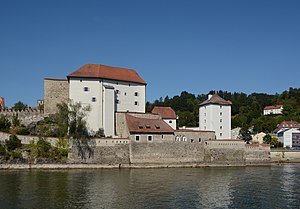Veste Niederhaus
| Veste Niederhaus | ||
|---|---|---|
|
The Veste Niederhaus from the opposite bank of the Danube |
||
| Alternative name (s): | Upper House, Lower House | |
| Creation time : | around 1250 | |
| Castle type : | Hilltop castle | |
| Conservation status: | Receive | |
| Place: | Passau - old town | |
| Geographical location | 48 ° 34 '32 " N , 13 ° 28' 28" E | |
|
|
||

The Niederhaus is a castle that stands in Passau on the tip of the rocky headland at the confluence of the Ilz and Danube rivers below the Oberhaus fortress . The headland, like the Ilzufer on the right, belongs to the Bschütt district of the Altstadt district to the north .
history
The first development on the headland is estimated to be in 737. This was a temporary residence that Duke Odilo of Bavaria had assigned to Bishop Vivilo with refugee nuns.
Today's hilltop castle already existed around the year 1250, as the construction bills of Prince-Bishop Otto von Lonsdorf differentiated between "old" and "new" castle. The names "Oberhaus" and "Niederhaus" have been in use since the middle of the 14th century.
In 1358 an accommodation room for 13 pilgrims was built in the large vaulted cellar , today's "Pilgrim's cellar " . As a connection between Niederhaus and Oberhaus, a double battlement was built in 1367 as a result of the occupation of the Niederhaus by the Passau citizens in the fight against the bishop .
In 1435 the castle was destroyed by a powder explosion. The reconstruction took place under Prince-Bishop Leonhard von Laiming and was completed in 1444 at the latest. In this year the future Pope Pius II reported on the magnificent halls and rooms of the Niederhaus. At that time, a knight's hall and two castle chapels served as a secondary residence for the bishops.
In the 17th century the Niederhaus was converted into a prison for unruly clergy. In 1762, under Prince-Bishop Joseph von Thun , Niederhaus was designated a workhouse and penitentiary .
The castle gained military importance in 1805, as it was used by the Elector of Bavaria as a war magazine and a blocking fort on the Danube. In order to give the guns on the Oberhaus fortress a free field of fire, renovation work had to be carried out on the Niederhaus fortress. The nine-story tower was demolished on four floors and half of the eastern keep was demolished.
In 1815 the castle walls on the Ilz, Danube and Holzgarten sides were extended and a howitzer battery was built. Niederhaus retained its fortifications until 1867.
In 1890 the history painter Ferdinand Wagner bought the Niederhaus. Ten years later it was decided to build the Luitpold Bridge , a suspension bridge over the Danube. Since the owner of the castle was against the construction of the bridge, he decided in 1907 to sell the Niederhaus to the painter Eduard Strobelberger.
Since the Niederhaus is still privately owned today, it is not open to the public.
literature
- Gottfried Schäffer , Gregor Peda: Castles and palaces in the Passau region . Pannonia Verlag, Freilassing 1977, ISBN 3-7897-0060-6 , pp. 26-27.
Web links
- Burgschloss Passau, Niederhaus on the homepage of the House of Bavarian History (plans, history, building history, existing buildings)
- Reconstruction drawing in the medieval state





